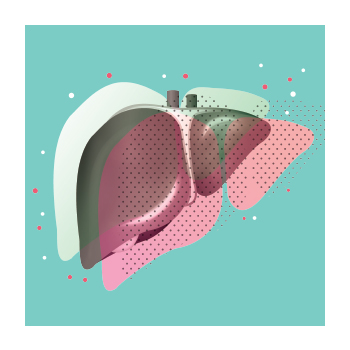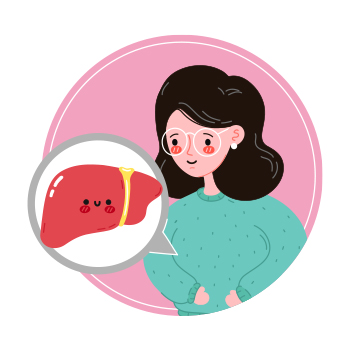


Sign-up for {N}power to get exclusive discounts, newsletters, members-only features, and more!

True or false: You can only damage your liver when you drink too much alcohol? FALSE.
While it is true that drinking too much alcohol can lead to alcohol-related liver disease, liver cirrhosis, and even liver failure, what’s not as widely known is that even those that drink little to no alcohol can still develop nonalcoholic fatty liver disease (NAFLD), an umbrella term for a range of liver conditions caused by eating a highly processed diet devoid of essential nutrients, prolonged pesticide exposure, glyphosate residues in foods,1 medication use, being obese, and being diagnosed with diabetes or metabolic syndrome. In fact, NAFLD, and its chief characteristic of too much fat stored in liver cells, is now the most common form of liver disease—a silent epidemic affecting about one-quarter of the population.2
 Even young children and adolescents are among the impacted, with studies showing that children and young adults with NAFLD have significantly higher rates of cancer and liver and cardio-metabolic mortality.3 The percentages of age groups diagnosed with NAFLD are as follows: adults (25%), adolescents 15 to 19 years (17%), and even children 10 to 14 years (11%).4
Even young children and adolescents are among the impacted, with studies showing that children and young adults with NAFLD have significantly higher rates of cancer and liver and cardio-metabolic mortality.3 The percentages of age groups diagnosed with NAFLD are as follows: adults (25%), adolescents 15 to 19 years (17%), and even children 10 to 14 years (11%).4
But with targeted liver-supportive nutrients and supplements and the right adaptations to diet, there are ways to eradicate NAFLD, and all of the health complications that come with it, before it takes an ever-greater hold on our nation’s health.
One of nature’s most effective liver tonics is milk thistle, as it contains a combination of flavonoids known collectively as silymarin. It facilitates the production and regeneration of healthy liver cells and has been used for centuries in the treatment of liver conditions and disorders.5 6 Silymarin acts as a free radical scavenger and is effective in reducing elevated liver enzymes, called alanine aminotransferases (ALT), associated with NAFLD. In fact, in an analysis of trials in patients with liver cirrhosis, those undergoing silymarin treatment saw a significant reduction in liver-related deaths. The recommended dosage is between 420 mg and 600 mg daily, with the majority of clinical trials using 140 mg three times a day.7 8
Milk thistle also promotes liver function by supporting healthy glutathione levels (the body’s master antioxidant found in almost every cell in the body). Most glutathione in the body is produced intracellularly in the liver from the amino acids cysteine, glutamate, and glycine. One of glutathione’s main functions is to aid in liver detoxification by binding to heavy metals, chemicals, and other toxic substances, making them more water-soluble so they can be removed through urine or stool.9 10
N-acetyl cysteine (NAC), a derivative of the amino acid L-cysteine, has also come into focus as a therapeutic supplement to help combat NAFLD. Evidence suggests that NAC blocks fat accumulation in the liver, improves liver function by reducing inflammation, and enhances intracellular antioxidants, namely glutathione.11 12 It’s commonly used to treat acetaminophen toxicity, which is known to be especially damaging to the liver.13 In one three-month study comparing the effects of NAC versus vitamin C on NAFLD patients, study participants either took 1,200 mg of NAC or 2,000 mg of vitamin C daily. Results showed that those taking NAC had significant decreases in liver enzyme ALT but found no similar changes in the patients receiving vitamin C.14
The plant compound berberine is uniquely suited to tackle the cluster of symptoms that often accompany NAFLD, including insulin resistance, high blood sugar, and high triglycerides; studies have consistently found that berberine reduces triglycerides, LDL cholesterol, and fasting blood sugar, improves insulin resistance, and reduces fat in the livers, while also improving liver function, in NAFLD patients.15 A recent randomized, controlled trial including 184 patients with NAFLD compared lifestyle intervention (diet and exercise), life style intervention plus pioglitazone (a diabetic drug, that should be noted, can cause or worsen heart failure), or lifestyle intervention plus berberine (500 mg, three times daily). Lifestyle intervention plus berberine resulted in a significant reduction in liver fat (57% compared to 36% in the lifestyle intervention group), a “remarkable” decrease in body weight, and better reductions in blood glucose, triglycerides, and cholesterol. Berberine was more effective than the drug in reducing body weight and improving triglyceride levels.16 Research has found that the liver contains the highest concentration of berberine metabolites (the breakdown products of berberine), containing about 70 times as much as what is found in the plasma.17
The amino acid glycine, found in high-protein foods and produced in the body naturally, has been researched primarily for sleep, mood, stroke, and heart disease.18 But lower circulating glycine is consistently reported in patients with NAFLD, and a 2020 study further connects low levels of this amino acid in NAFLD’s development.19 The lead author stated, “…lower circulating glycine is consistently reported in patients with NAFLD and related comorbidities including diabetes, obesity, and cardiovascular diseases. Our studies not only offer a metabolic explanation for defective glycine metabolism in NAFLD, but also uncover a potential glycine-based treatment."20 In short, “Glycine-based treatment improves NAFLD by modulating fatty acid oxidation, glutathione synthesis, and the gut microbiome.”21
Black seed oil has a history of use in traditional medicine for the treatment of liver diseases. In one randomized, double-blind, placebo-controlled trial of 120 adults with NAFLD, 2.5 ml, equating to 2,500 mg of black seed oil, every 12 hours lead to a significant reduction in fatty liver in the oil group compared to the placebo group. The results deemed black seed oil safe and noted improved liver function, reduced liver injury, as well as improved triglyceride and cholesterol levels in the NAFLD patients.22
New research shows that vitamin B12 and folic acid are inexpensive tools that could be used to prevent and/or delay the progression of an advanced form of NAFLD. It has been previously shown that high levels of homocysteine (an amino acid that vitamins B12, B6, and folate are required to breakdown) is associated with NAFLD progression. Elevated homocysteine increases the risk for other serious health issues and also blocks a protein in the liver (syntaxin 17) responsible for transporting and digesting fat for metabolism, maintaining mitochondrial turnover, and preventing inflammation. Without this protein, fatty liver disease progresses. But supplementing with vitamin B12 and folic acid increases syntaxin 17 levels and restores its role in promoting liver health. It also reverses liver inflammation and fibrosis.23
The essential nutrient choline rounds out the liver-loving nutrients you may be lacking. Choline supports fat metabolism, helps reduce chronic inflammation, and has been shown to lower the risk of NAFLD. In fact, fatty liver disease and liver cell death occur when deprived of choline. It is metabolized in the liver, where it’s converted into phosphatidylcholine, which assists in transporting fats out of the liver.24 25 While the liver produces small amounts of choline, deficiencies may be more prevalent than expected, with one study showing that only approximately 8 percent of U.S. adults are getting enough choline. However, among egg consumers (egg yolks are a rich source of choline) 57 percent met the adequate intake levels.26 The recommended amounts for women and men are 425 mg and 550 mg, respectively.27
 While adding supplements to your regimen can do wonders for liver health, having an optimal diet loaded with liver-loving organic fruits + vegetables is another powerful way to support it at the source. Fresh produce is an important part of any healthy lifestyle, but it’s crucial to choose organic when upping your veggie game because studies show that even ultra-low levels of glyphosate residues, commonly found on conventional produce and in everyday grocery items like cereal and oatmeal, can increase the risk of developing NAFLD and lead to the impairment of liver function.28
While adding supplements to your regimen can do wonders for liver health, having an optimal diet loaded with liver-loving organic fruits + vegetables is another powerful way to support it at the source. Fresh produce is an important part of any healthy lifestyle, but it’s crucial to choose organic when upping your veggie game because studies show that even ultra-low levels of glyphosate residues, commonly found on conventional produce and in everyday grocery items like cereal and oatmeal, can increase the risk of developing NAFLD and lead to the impairment of liver function.28
Chia seeds are a fantastic liver-supportive food to add to your diet. They’re rich in the omega-3 fatty acid alpha-linolenic acid (ALA), antioxidants, and fiber, and have even been shown in studies to combat NAFLD. In one recent study, the effect of 25 g/day of milled chia was assessed in 25 patients with NAFLD; after eight weeks of a chia-supplemented diet, NAFLD regressed in 52 percent of the treated patients.29
Broccoli sprouts are the richest food source of sulforaphane, a phytonutrient that possesses anti-inflammatory properties and aids in detoxification and reduces liver damage.30 In one randomized, double-blind, placebo-controlled study of men with fatty liver disease, those who took broccoli sprout extract for two months showed significantly decreased liver enzyme levels (ALT) and oxidative stress markers compared to the placebo group. The broccoli sprout capsule contained an equivalent of 10 mg of glucoraphanin, a precursor to sulforaphane.31



Sign-up for {N}power to get exclusive discounts, newsletters, members-only features, and more!